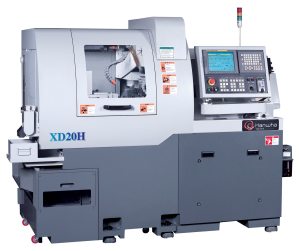There are two main types of Swiss screw machines: automatic and CNC. The automatic screw machine functions with a disc cam, which rotates the tools to the work-piece bay. A collet holds the work-piece in place. The disc cams move the tools in a radial motion, but also alter headstock positioning in order to account for longitudinal discrepancies with the work-piece. The automatic Swiss screw machine features very close spindle collets, which prevent much deflected debris from becoming a problem.
CNC Swiss screw machines, also called CNC turning machines or lathes, operate largely on the same principle as an automatic Swiss screw machine, except the operation is controlled by a CNC unit. Because of the increased direction provided by the CNC, these turning machines can feature more sets of tooling, allowing for the machine to perform several operations on the same piece in a shorter amount of time. Automatic Swiss screw machines can also perform several operations, but lacks the precision and swiftness as a CNC unit. A CNC Swiss screw machine can rotate a part at up to 10,000RPM at an accuracy level of 0.0002 to 0.0005 inches.
Both automatic and CNC Swiss screw machines are relatively cost efficient for longer projects because, once properly tooled and program oriented, many machines can run under the supervision of one operator. This low variable increases a Swiss screw machine’s appeal, although preparation time can be up to an hour, so shorter projects’ fixed costs might balance out for another tooling process. At the same time, Swiss screw machines are able to do more precision work due to the tight, close quarters of the collet, work-piece, and tooling, so multiple factors are at play in process selection.

